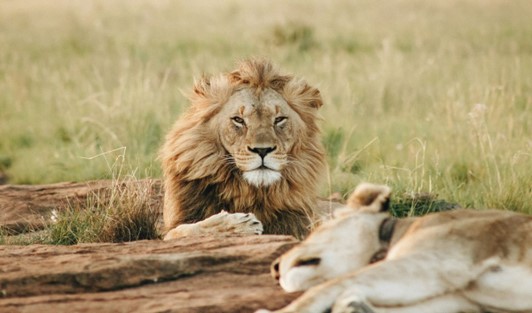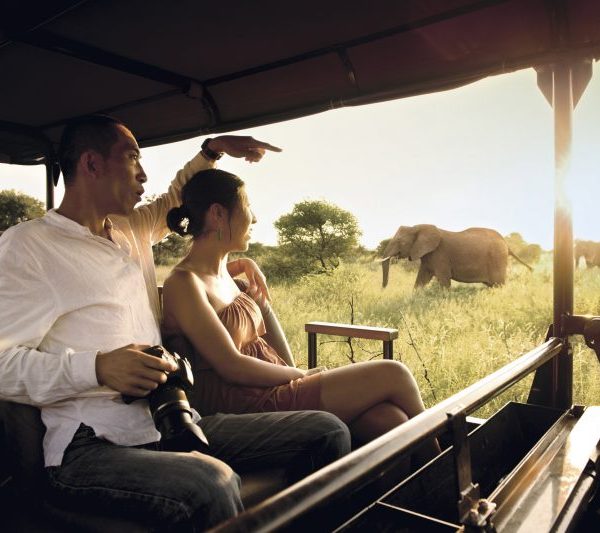What Are the Big Five?
The Big Five are Africa’s top wildlife attractions. This group includes the Elephant, Buffalo, Lion, Leopard, and Rhinoceros. Big game hunters in the 1800s named these animals for being the most dangerous to hunt on foot. Now, these animals are the main draw for safari adventures, attracting wildlife lovers worldwide.
- Elephant: Earth’s largest land animal, known for its smarts and social bonds.
- Buffalo: Unpredictable and tough, making them exciting to spot.
- Lion: The group-living big cat with fascinating pride dynamics.
- Leopard: Stealthy and well-camouflaged, often seen relaxing in trees.
- Rhinoceros: Critically endangered, with horns that poachers sadly target.
Seeing the Big Five is a dream for many travelers. These animals are important not just for their size or the thrill of spotting them. They play a key role in conservation. Through tourism, they help fund efforts to protect their homes and support nearby communities.
Watching these animals in the wild is more than a chance for photos. It’s about learning how they act, understanding their place in nature, and realizing why we need to protect them for the future.
In the safari world, the Big Five aren’t just a checklist. They represent the essence of the wild, showing nature’s beauty and strength.
Best Times for Big Five Sightings
Want to catch the Big Five in action? The peak safari season from July to October is your best bet. This period coincides with Africa’s cool, dry winter, making it prime time for wildlife viewing.
During these months, the vegetation thins out, giving you a clearer view of the animals. Water sources become scarce, so wildlife gathers around rivers and waterholes, making them easier to spot.
- Botswana’s Chobe River: Dry season here means large herds of elephants and buffalo. It’s a sight you won’t forget.
- Namibia: From July to September, rhinos are more visible as they avoid the rainy season. Perfect for those rare sightings.
- Kenya’s Maasai Mara: This is when the Great Migration happens. You’ll witness thousands of wildebeest and zebras, along with the Big Five. Explore our Kenya Safaris for more details on experiencing this incredible event.
- Tanzania’s Serengeti: Similar to the Mara, but with fewer crowds. Great for those who want a bit more solitude. Discover the beauty of the Serengeti through our Tanzania safari tours.
- South Africa’s Kruger National Park: Winter months here offer excellent opportunities to see lions, elephants, and more. The cooler weather also makes for a more comfortable experience.
Planning your trip during these months? You’re in for some unforgettable wildlife encounters.
Top Destinations to See the Big Five
Seeing the Big Five in their natural habitats is a safari highlight. Here are the top spots for unforgettable encounters:
- Tanzania’s Ngorongoro Crater: This UNESCO World Heritage site is a wildlife haven. The crater floor is home to a dense population of lions, elephants, and buffalo. Rhinos are often spotted here too.
- Serengeti National Park: Known for the Great Migration, the Serengeti offers ample opportunities to see the Big Five amid vast, open plains.
- South Africa’s Kruger National Park: One of Africa’s largest game reserves, Kruger is a Big Five hotspot. It’s renowned for its accessibility and diverse wildlife.
- Sabi Sand Game Reserve: Adjacent to Kruger, this private reserve is famous for leopard sightings. The intimate setting allows for up-close encounters.
- Botswana’s Moremi Game Reserve: Located in the Okavango Delta, Moremi boasts a high density of wildlife. Elephants and lions are frequently seen here.
- Linyanti: Also in Botswana, this area is known for its large elephant herds and predator sightings, including lions and leopards.
- Zimbabwe’s Hwange National Park: This park is home to one of the largest elephant populations in Africa. It’s also great for spotting lions and buffalo.
- Namibia’s Etosha National Park: Etosha’s waterholes attract a variety of wildlife, making it easier to spot the Big Five.
- Kenya’s Maasai Mara: Famous for the annual wildebeest migration, the Mara is a prime location for Big Five sightings. Lions and elephants are particularly abundant here. For more information on the diverse safari and coastal experiences in Kenya, including the Maasai Mara, you can explore Kenya’s top safari destinations.
Each destination offers something unique, whether it’s the dense wildlife of Ngorongoro Crater or the picturesque landscapes of the Maasai Mara. These spots promise thrilling and memorable Big Five experiences. For an in-depth journey that covers both Kenya and Tanzania’s iconic wildlife habitats, consider our Big Cat Safari, which spans 12 nights and 13 days.

Photography Tips for the Big Five
Capturing the Big Five on camera is an art. Here are some tips to help you get those perfect shots.
Use wide-angle lenses to place animals in their stunning landscapes. This adds context to your photos, showing the environment where these majestic creatures roam. For intimate shots, switch to zoom lenses. This lets you capture fine details like a lion’s mane or an elephant’s wrinkles.
Timing is everything. Early mornings and late afternoons are ideal for photography. Animals are more active, and the lighting is softer. During the day, you might catch them resting in the shade. Dusk and dawn are prime times for hunting or feeding, offering dynamic shots.
Here are some settings to consider:
- Leopards in trees: Use the spot meter function to get the correct exposure. These cats love hiding in tree branches, so this setting helps focus on them amid the foliage.
- Low light conditions: Increase your ISO. This is especially useful during night drives in private reserves. It helps in capturing clear images even when light is scarce.
- Animal eyes: Focus on the eyes. They are the window to their soul and make your photos more evocative.
Unique opportunities like night drives offer a different perspective. You might see nocturnal behaviors that are otherwise missed, giving you a chance to capture raw, unfiltered moments. For instance, during our 7 Days Highlight of Kenya Urban & Bush Safari, guests have the chance to experience diverse wildlife activities, including night drives that provide a different lens on the animal kingdom.
- Ground-level shots: Emphasize the size and power of these animals by shooting from ground level. It gives a dramatic sense of scale.
Patience is key. Sometimes, the best shots come after hours of waiting. Stay calm, be ready, and let the wild moments unfold naturally.
Additional Wildlife and Experiences
The Big Five might be the headliners, but East Africa’s wildlife roster is packed with stars. Beyond the famous five, there’s so much more to see on a safari.
- The Ugly Five: Don’t be put off by the name. Hyenas, vultures, Marabou storks, warthogs, and wildebeests have their own unique charm. Watching a pack of hyenas in action or a group of warthogs scurrying across the plains can be just as thrilling.
- Birding Opportunities: East Africa is a birdwatcher’s paradise. Picture flamingos at Lake Nakuru, painting the horizon pink. Or spot the colorful lilac-breasted roller fluttering by. With hundreds of bird species, there’s always something to catch your eye.
- Plains Game: Zebras, giraffes, and antelopes are the true icons of the savannah. Their grace and numbers create a visual spectacle that’s hard to match. Watch zebras grazing in the golden light or giraffes stretching their necks to nibble on treetops.
- Mountain Gorillas: Head to Rwanda or Uganda for a once-in-a-lifetime encounter with mountain gorillas. Trek through dense forests and come face-to-face with these gentle giants. Their human-like behavior is both fascinating and humbling.
- African Wild Dogs: These endangered predators are a rare treat. Places like Tswalu in South Africa offer the chance to see these painted wolves in action. Their pack dynamics and hunting strategies are a marvel of nature.
Each of these encounters adds a new layer to your safari experience. You’re not just ticking off a checklist. You’re diving into the rich tapestry of East Africa’s wildlife. For those interested in a comprehensive safari experience, consider our 4 Days Tarangire, Lake Manyara, and Lake Eyasi Safari which offers an array of wildlife encounters beyond the Big Five.
Conservation and Responsible Travel
Sustainable travel choices support wildlife conservation. Your decisions impact natural habitats and local communities directly.
Tourism funds conservation efforts. Eco-friendly safaris finance protected areas and reserves that preserve wildlife. Your money helps fight poaching, wildlife trafficking, and habitat loss.
Tourism often leads to successful conservation. Take Ol Pejeta Conservancy in Kenya. It’s now a safe haven for endangered species like black rhinos, thanks to visitor funding. The Lewa Wildlife Conservancy has seen rhino and Grevy’s zebra numbers grow, partly due to eco-tourism.
Here’s how to travel responsibly:
- Pick Eco-Friendly Lodging: Stay at places that prioritize sustainability. Look for renewable energy use, waste recycling, and local community support.
- Skip Harmful Activities: Don’t ride elephants or take selfies with wildlife. These activities exploit animals.
- Help Local Communities: Buy local goods, eat at local spots, and join cultural experiences that benefit locals.
- Respect Wildlife: Keep your distance from animals. Don’t feed them or disrupt their natural behavior.
Responsible travel has a positive ripple effect. It helps preserve wildlife for future generations and ensures local communities benefit from tourism. By traveling mindfully, you help maintain East Africa’s incredible ecosystems for the long term. For more insights on how to explore these ecosystems, consider our 11-day premier East African safari in Kenya and Tanzania, which showcases diverse landscapes and unique wildlife.

Planning Your Big Five Safari
Planning your Big Five safari is exciting. Timing matters. The best wildlife viewing happens from July to October during peak season. Animals gather near water sources in the dry season, making sightings easier.
The Maasai Mara and Serengeti become wildlife hotspots during these months. Picture seeing the Great Migration or a pride of lions at dawn. Each place offers a unique experience.
Seeing the Big Five isn’t just about ticking boxes. It’s about understanding their role in nature and why we need to protect them. Your safari helps local communities and wildlife conservation. This makes your trip more meaningful.
Pick the right safari to enhance your journey. You might choose a luxury lodge with great views, an off-the-beaten-path trip, or a tour with local experts. Each option adds something special to your adventure.
Responsible travel protects these amazing animals and their homes for the future. Respect wildlife, stay at eco-friendly places, and connect with local people. Your choices matter.
Get ready for lasting memories and close wildlife encounters. A Big Five safari offers adventure, learning, and a bond with nature. It’s time to plan your dream safari. Let’s Plan it together!



